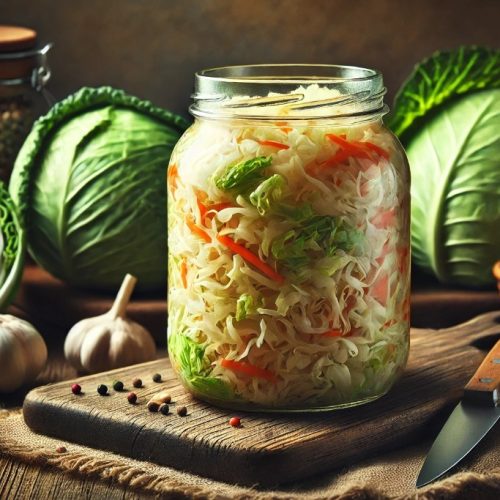
Sauerkraut Recipe
Sauerkraut Recipe, a tangy fermented cabbage dish, is loved for its flavor and health benefits. Easy to make at home, it’s packed with probiotics, vitamins, and fiber for better gut health.
Ingredients
- 1 Medium Head - Cabbage
- 1-2 tbsp Sea Salt
- 1/2 - 1 cup Shredded Carrots
- 1/2 - 1 cup Grated - Beets
- 2-3 cloves Minced - Garlic
- 1- inch Piece Grated - Ginger
- 1-2 Sprigs Fresh, Herbs
Instructions
- Start by removing any damaged or wilted outer leaves from the cabbage. Then, cut the cabbage into quarters and remove the tough core from each section.
- Shred the cabbage into thin, even strips using a sharp knife or a mandolin slicer. The finer you shred the cabbage, the better it will release moisture, which is essential for creating the brine.
- Place the shredded cabbage in a large mixing bowl and sprinkle the sea salt over the top. Begin massaging the salt into the cabbage with your hands. Use a firm but gentle pressure to knead the cabbage for about 10 minutes.
- This step is crucial as it draws out the cabbage’s natural water content, which will combine with the salt to create the brine needed for fermentation. As you massage, you should notice the cabbage wilting and becoming wet.
- If you’re using additional flavorings like shredded carrots, beets, garlic, or ginger, now is the time to mix them in. Add them to the cabbage and salt mixture and continue massaging for a few more minutes. The flavors will infuse the cabbage and brine during fermentation.
- Sterilize your jars before use to ensure a clean fermentation process. Once the cabbage mixture is ready, begin packing it into your jars. Use clean hands or a tamper to press the cabbage tightly into the jars.
- The goal is to ensure that the cabbage is fully submerged in its brine. Leave about 1 to 2 inches of space at the top of the jar to allow for expansion during fermentation.
- If there isn’t enough brine to cover the cabbage, you can make a simple brine by dissolving 1 teaspoon of salt in a cup of water and adding it to the jar until the cabbage is submerged.
- Seal the jars with a lid or cover them with a cloth, securing it with a rubber band. Leave the jars in a warm, dark place, ideally between 65°F (18°C) and 72°F (22°C), for 3-14 days. During this time, the cabbage will ferment, and the flavors will develop.
- Each day, check the jars and press the cabbage down to ensure it remains submerged in the brine. You can open the jar to release gas buildup from fermentation, but always make sure to close it again afterward.
- Start tasting your sauerkraut after 3 days of fermentation. The longer it ferments, the tangier and more complex the flavor will become.
- Once it reaches the level of tanginess you prefer, transfer the sauerkraut to the refrigerator to slow down the fermentation process. The cold temperature will preserve the sauerkraut and it will last for up to 6 months.